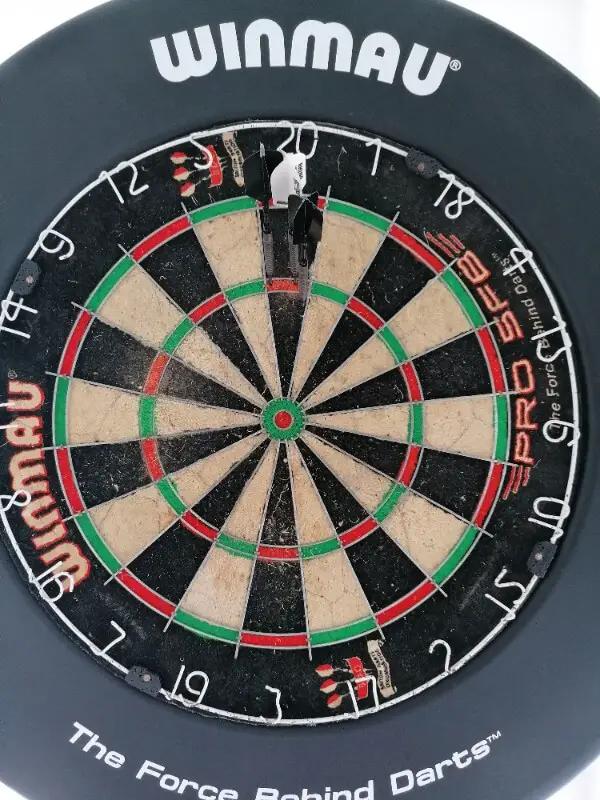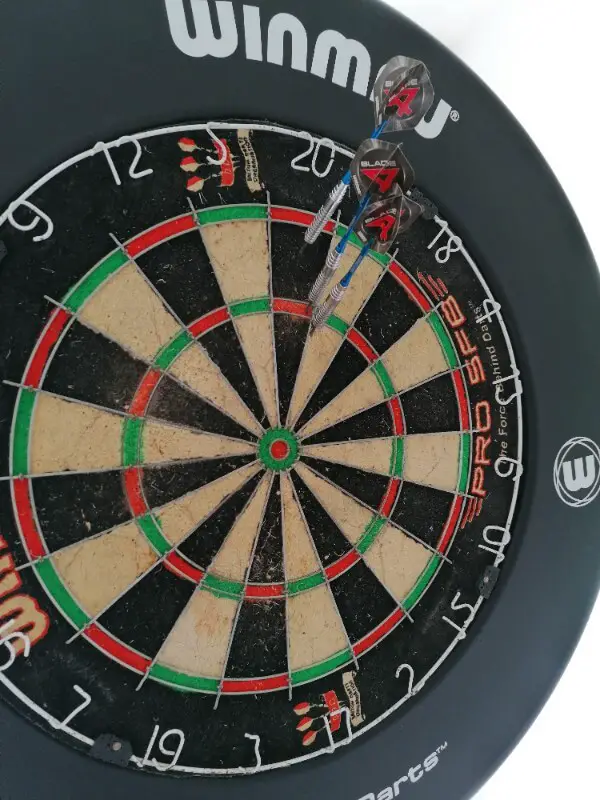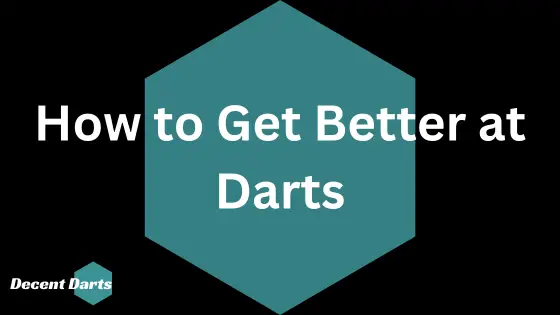There is always a period when playing darts that you realize this is something that you could actually be good at.
I’m not going to say darts is easy but it is something that most people can get to a high standard with enough practice.
When you consider how to get better at darts, you’ll find there is a process.
Initially, I wanted to write this article to give some good tips to help beginners get better at darts but then I realized that my tips would likely either be generic or not helpful for true beginners.
I’m not a great player but I win more than I lose, I’ll hit my fair share of 180s, I can group 3 darts fairly well and finish a game of 501 in around 24-30 darts on average (which is a good standard according to this page). Oh, and I’m right-handed which is an important point.
To get better though, I will typically watch and read advanced tips.
These however will offer no benefit to someone that just wants to learn to become more consistent and hit their doubles faster, whilst getting some 100+ scores.
Therefore, I decided to try something different…
How I Practiced To Get Better at Darts
I practiced for two weeks (consistently) and I also learned to play darts with my left hand!
Now, two weeks might not seem like much but as mentioned above, I can already play darts to a decent club standard, win more games than I lose but also rarely play – a few practice sessions per week, if that.
Therefore, two solid weeks of practice just sharpen and refine some rusty skills.
Alongside that, yes, to find out how I could produce an article that would really help players get better when just starting out or at a beginner level, I decided to start from scratch and learn to play with my left hand.
This is to see what the difficulties are when starting and what will work best to improve.
This might seem strange but once you get to a relatively good standard in something, you soon forget what it takes to actually get to that standard in the first place.
Therefore, In this article, I’m going to combine some tried and tested tips along with my experience starting from scratch.
Before reading on, this is how I throw with my right hand:

And this is how I started with my left hand:

Noticeable difference and I’d imagine that if you are reading this, your darts are less like the first picture and more similar to the second.
By the end of this article, you will hopefully pick up some points that will help straight away and also see what 10 – 20 hours of dedicated practice can do when you focus on the right things.
How to Get Better at Darts
The structure of this article is going to be the following:
Points 1-4: Quick wins
Points 5-6: Experiment
Points 7-8: Long term progress
I’ll take you through the first steps needed to get better at darts but these will be quick wins and not your standard “how to hold a dart” type of tips.
Though that is, of course, important and I recommend checking out that article as that is something that should come before you even consider getting better, it’s a prerequisite!
Once you’ve got some quick wins out of the way, which are usually the easy adjustments you can make to your game, we’ll cover some of the more advanced practice routines to develop your accuracy, consistency, scoring power, and finishing.
1. Improve Your Aim by Finding Your Dominant Eye
This is not your typical, generic tip but this is the one that I’ll use for your number 1 quick win.
It can be frustrating when starting out and seeing no improvement in your accuracy or game and an obvious answer could be that you’re not aiming correctly but the real issue is that you’re not aiming correctly.
There’s a quick adjustment that you can make to instantly ensure you start throwing where you are aiming and this is to find out what your dominant eye is.
You might throw a dart with your arm, hand and wrist but where you aim is dictated by your eye(s) and most people will have a dominant eye.
If you’re not aiming with your dominant eye then chances are your dart is not going to go where you are looking (or at least think you are looking).
To find your dominant eye there is a simple test you can take and I’ll run you through it now.
How to Find Your Dominant Eye
To find your dominant eye, create a diamond with your fingers and thumbs like in the image below.

Now hold it up in front of you and focus through the diamond-shaped hole you’ve created on a fixed object 5ft – 10ft away.
In this example, I’m focusing on the bullseye on the dartboard.
** note that when looking through this hole with both eyes open, it will likely be blurry and unfocused but stay with me on this and you’ll see why.
Now, hold your gaze on the fixed point through the hole in your fingers and only focus on the object.
In this example, I am only focusing on the bullseye. Taking turns, you will hold your hands steady and close one eye starting with your left eye.
Has the bullseye (or whatever object you’re looking at) stayed in focus?
Now keep your hands in the same position and close your right eye whilst keeping the left eye open.
Has the bullseye (or whatever object you’re looking at) stayed in focus?
What you will likely find is that when closing eyes, one eye, in particular, will keep the object in sight through the hole in your fingers whereas closing another eye has likely moved it out of focus completely.
The eye that keeps the object in view through your diamond-shaped hole is your dominant eye and this is the eye that you should be aiming your darts with.
When I do this test and close my left eye, the object stays in view because I’m right eye dominant but when I close my right eye, the focus through my fingers moves an entire 2 feet to the right.
The bullseye is no longer even in view.
This means if you are trying to line darts up but focusing with your non-dominant eye, the dart might be going somewhere that you didn’t even realize you were aiming.
In my example, the dart won’t go 2 feet off to the right when throwing because my right eye is still helping to aim but to improve my aim, I can simply line the dart up in front of my right eye to throw.
This small adjustment will allow you to actually throw where you are aiming and is the single quickest improvement you can make to your throw.
2. Get a Stable Stance
Now that you know where you should be aiming with your hand-eye coordination, the second step to getting better at darts is to ensure your body is doing the same.
A solid and stable stance is often a neglected aspect that stops most players from achieving a consistent throw.
If you sway slightly during a throw – or have any body movement at all – then it will be next to impossible to throw the same shot or make adjustments between throws.
When throwing darts, the only thing that should be moving is your forearm as the fewer moving parts, the more accurate your aim and throw will be.
Some players try to lean over the line in darts to narrow the throwing distance (which makes sense from a mathematical viewpoint) but this leaning will put most players off balance and result in a less consistent throw.
To take a stable darts stance for beginners, take your dominant foot which is the one underneath the arm you’ll throw with, and stand against the throw line with a 45-degree bend.
Your body will not be completely side-on when facing the board but also won’t be square on with the board.
Your back foot should take 10% – 20% of the weight (with your front foot taking the majority of your body weight).
The video below will give a more visual walkthrough for your stance as it’s much more difficult to describe over text.
3. Get a Consistent Throw
This is something that comes over time and I was debating putting it in the long-term section later on in this article but after practicing with my left hand for a few hours, I quickly found that throwing your darts the same every time is more important than accuracy.
Accuracy comes with practice but you need a consistent throw to eventually become accurate.
What I mean by this is that when I throw 3 darts with my right hand, they all go around or in the treble 20 (when aiming for it).
When I threw with my left hand, the motion was slightly different each time as I was thinking about the throw, and as a result, I’d get a single dart in the 20 if I was lucky.
The 3 darts were scattered around the board with no grouping whatsoever.
Some even missed the board and if it wasn’t for my dartboard surround, I’d have some damaged walls and flooring!
Therefore, what you need to practice at first is throwing the same throw every time. Focus less on aiming for a specific number and instead try to throw the exact same throw with all 3 darts.
This will take a few hours of practice but it will significantly speed up your accuracy thanks to muscle memory and intrinsic feedback.
Your throwing action needs to be smooth and consistent so just focus on performing the same throw every time, it doesn’t matter where the darts go as long as the action is the same every time.
4. Learn Your Dart Maths
You might not enjoy math but I’ve just spent time explaining how you need to ensure your throw is consistent and nothing ruins consistency more than hesitancy during a throw.
A non-physical aspect of hesitancy during a throw is not knowing your dart math or what number you need to throw for.
When scoring from 501 down to around 150, the only thing you really need to focus on is hitting the treble 20 (or making a cover shot on the 19s).
Throwing a loose dart and hitting a random number may make calculating your score difficult but you don’t need to worry about that during your free, just continue aiming for a high treble score.
From 150 and under though, you’ll now need to start considering your darts carefully to leave yourself on an outshot.
This is where a missed dart can really hinder your accuracy or throwing rhythm. Most dart players are not necessarily good at math though…
The key is just to memorize outshots.
Start simple and learn the checkouts that will leave you on your favorite double. For most people, this will be double 20 or double 16 (though some also like double 18).
If you have a score of 52 as an example, you can either hit a single 12 to leave double 20 or a single 20 to leave double 16.
Learn your two dart outshots first before progressing to three dart outshots.
These are harder to learn and have more variations so start slowly and just memorize your favorites.
You can also get a darts checkout guide or outshot card which lists all the most common checkouts from 2 right the way to 170.
Something I also came across recently is this outshot dart mat. I’ve not used it personally but it looks to be made from high-quality material and is ideal for beginners so check it out on Amazon here.
You can also get a dart scorer but in my opinion, you’ll start to rely on this too much during game situations, which is when it matters the most.
Learning dart math is undoubtedly more difficult in the beginning but once you can calculate your score without thinking, you’ll be 10x more consistent when throwing.
5. Find the Dart Best Suited to You (Including Flights and Shafts)
When starting out in darts, trial and error are important.
You’re still trying to figure out what feels comfortable in terms of your dart grip and you’ll definitely be spending some time trying to get your darts trajectory more stable (to stop darts landing sideways or wobbling in the air).
A key to this is finding the right size, shape, and set up for your darts.
Darts come in a range of sizes, lengths and can also be front-loaded, rear-loaded, or balanced in terms of weight distribution.
When you get comfortable throwing with a certain type of dart, it can be difficult to then switch in the future.
For this reason, trial and error is necessary for beginners. You should try to use as many different darts as possible to find what suits your grip and throw style (whilst also learning to get comfortable with this).
My first ever set was an Eric Bristow set that was front weighted and had quite a wide barrel.

After joining a league though, I soon realized that the wide barrel was stopping me from grouping my darts and made it very difficult when getting a dart close to a double (blocking it off).
I therefore upgraded to a Red Dragon set with a much thinner barrel and evenly distributed weight.
While I had to adjust my grip I found I was a much better player and this was because I didn’t experiment when I first started playing so I just stuck with a set that didn’t suit my throw.
To do it all again, I’d definitely recommend testing as many darts as possible to find a set that suits you personally.
For tips on getting started check out our guides here:
– Best tungsten darts
– Choosing darts for beginners
6. Play Against Better Players
Practicing on your own is one thing but skills can rarely be enhanced without some form of competition.
Playing practice games is good for developing your skill set but in competition situations, nerves, shaky hands, sweaty palms and a range of other factors are present that are very hard to imitate or emulate when playing solo.
Top pro darters have the mental ability to practice as though they are in-game situations and have a “switch” that allows them to focus during practice.
The key to practice is a deliberate and intentional focus on certain aspects of your game (which we’ll cover shortly) but there is a shortcut that you should consider and this is playing against better players.
As a youngster, I learned to play darts against my grandad. He’s got about 50 trophies that he’s won (individuals, pairs, teams) so I could never beat him.
The more I practiced though… The more I still lost because at 85 years of age he still plays in a local league and is the joint top for wins in his team.

Eventually, though, I started to win the occasional game, and even further into the future, I could give him a really good game.
This was roughly 4-5 years of just casual games whenever I went to visit (alongside occasional practice at home) but once I started to play against other players, they weren’t as good as my grandad.
Despite being solid players – as I was used to playing against a good standard player, other players actually seemed easy to beat!
When I joined a league I won far more than I lost just because I spent years practicing against someone better which meant I had to try and raise my level and improve.
Playing against someone better than you means that you can learn first hand how they play and it gives you a standard to aim for.
The best example you’ll ever see of this in darts is that Adrian Lewis would be Phil Taylor’s practice partner.
When you play against and practice with one of the best dart players of all time, it’s hardly surprising that Adrian was able to raise his game and become a top PDC player in his own right.
7. Play Darts Practice Games
If you just walk up to the board and throw for the treble 20 for 20 – 30 minutes a few times per week, you’ll never improve as a player.
There is a big difference between learning the mechanics of a single throw or learning how to make adjustments to your throw around the entire board.
To get better at darts you need deliberate and intentional practice like I mentioned earlier.
This means you need to have a range of go-to practice games based on areas of your game that you want to improve.
This should include practice games for hitting doubles, scoring, switching (cover shots), and becoming more comfortable using the entire board.
There are multiple practice games you can get started with so check out the link above ^^ to find some that best suits you.
8. Join a Darts Team
My final tip for getting better at darts is to join a local darts team.
If the thought of joining a team seems intimidating, you should consider playing some games on an online streaming platform.
This is to get some competitive experience and test your matchplay nerves.
Nothing accelerates progress faster than some competition and winning your first competitive darts match is usually the springboard to truly take your game to the next level.
With competition comes confidence, even when losing games, you’re getting crucial experience like playing under pressure or taking game-winning shots.
Elite athletes like Michael Jordan and Kobe Bryant both had the mentality that you need to take the difficult, game-winning shots and test yourself against the best in order to become the best.
Even if you’re not intending on testing the PDC circuit, adopting this mentality and playing for a team will quickly give you the mental attributes needed to become a solid player within just a single playing season.
My Progress
So, after applying some of the above tips and playing with my left hand for a solid week of practice, these are the end results.

You’ll notice that I actually used a different set of darts than my preferred (and much better) set.
This backs up point number 5 as the wider barrel felt more comfortable to grip with my weaker – beginner standard – hand.
Grasping my other set with my stronger hand felt completely natural but the thin barrel and lack of motor skills with my left hand meant I couldn’t throw the darts naturally even as a beginner.
When swapping darts though, it felt much more comfortable with my weaker hand which emphasizes the need to test different darts.
Also, I’m not hitting 100+ scores but the occasional treble is certainly an improvement in just a week!
After practicing for two weeks with my strong hand, I had mixed results.

^^ though the last day of practice was my best average!
This goes to show how easy it can be to make noticeable improvements at the beginner level but once you have a steady throw and consistent finish.
It becomes much more difficult for a semi-decent player to make further improvements in a short space of time.
A 14 dart leg and handful of 180s are promising though so I’ll definitely be doing a follow-up series testing some professional dart player’s practice routines to see if I can bring my game up a level.
Final Thoughts
Getting better at darts is something that seems straightforward or simple – in theory – but when it comes to practice time, few people really know how to get better at darts and start to win some games.
By using the above list as an initial checklist, you should look to tick off some of the tips one by one, and within 6 – 12 months, you can easily take your game from a complete beginner standard to someone capable of competing at a good league level.
In a year, I’ll also release a revised list and see how much I can bring up my left-handed game (just for the fun of it) so watch this space…

